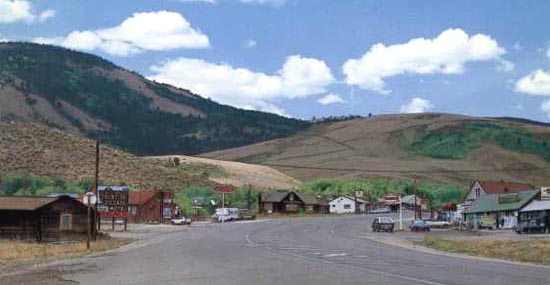
Centennial, Wyo., 1970's
Centennial is about 45 miles west of Laramie at the foot of the Snowy Range. Its
history is that of failed dreams, in the words of Cheyenne historian Robert G. Rosenberg it is a
"mere footnote in the mining history of the western United States." According to Rosenberg, the mining
rushes in 1876, 1902,, and 1923-1924 "were larely based 'on wishful thinking, irresponsible distortion of
the facts by the media, and promotional schemes.'" Historic American Engineering Record, file No. WY-16

Centennial, Wyo., 1920's
The two-story building at the right of the above photo is the "Mountain View Hotel" constructed as part
of mining promotional scheme in the early 1900's. The hotel is now on the national register.
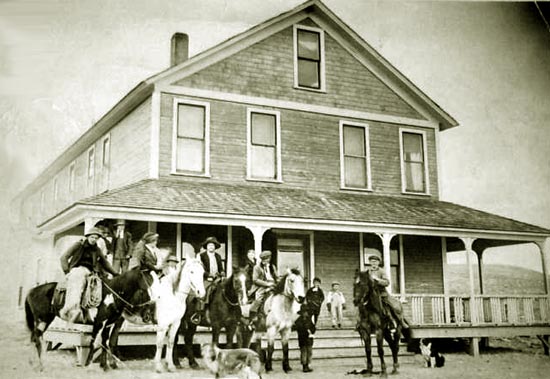
Mountain View Hotel, Centennial, Wyo., approx. 1914
The first
settlement in the area of present day Centennial were tie camps established in
1868 to provide railroad ties to the Union Pacific with the first homestead the following
year. Shortly thereafter, the tie hacks had to withdraw from the area due to
disagreements with the Indians. In 1875 by I. P. Lambing
of Golden, Colorado, discovered the Centennial Mine named in honor of the
country's hundredth anniversary. In 1877, the vein of gold ended at a fault.
The continuation of the vein on the other side of the fault has never been found. Thus,
the original mines failed. Prospectors continued to hope.

Centennial, in the distance, from the Snowy Range Road, 1930's.
The buildings on the curve are the Mullen Creek Civilian Conservation Corps Camp. See next photo.
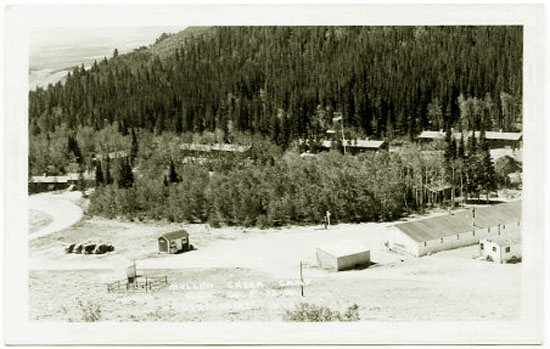
Mullen Creek Civilian Conservation Corps Camp.
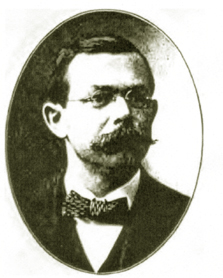 Issac Van Horn Issac Van Horn
The most important of the promotional schemes were those of Isaac Van Horn, Fred A. Miller, and
Edward R. Miller. On May 16, 1905, the Acme Consolidated Gold & Mining Company,
capitalized at $1,000,000.00 was organized
under the laws of the State of Wyoming with Isaac Van Horn, President; Arthur S. Howe, Secretary and
Treasuer, and Fred A. Miller, as general manager.
Acme was a holding company for the Acme Gold & Copper Mining Co. and had an
interlocking board of directors with the Laramie, Hahn's Peak and Pacific Railroad Company and the
Northern Colorado Coal Co. both of which were also incorporated under Wyoming Law and had their
respective business offices in Laramie. One prospectus for the three companies was issued under the
name "Boswyocolo Company." The prospectus promised that the companies were "a new idea in
finance; illusrated with views in such a way that its legitimate and sound basis cannot be
questioned by the most conservative." Van Horn was also president of the Railroad and
Edward R. Miller vice-president of the Coal Company. The reference to"Bos" was to Boston where Col.
Van Horn maintained his office as an investment broker and possibly to the "Boston Hotel Company" another Van Horn operation.
While the prospectuses may not have contained outright lies, in some instances they were misleading. The promotion for the
Hotel Company was accompanied by a photograph of the Union Pacific Hotel in Laramie. The prospectus did not actually say that it
was one of the Company's hotel. In promoting the Centennial Valley, one
prospectus depicted a "typical ranch." The photograph was of Menor's Ferry in Jackson's Hole.
The Company had acquired mining rights in Gold Hill about 35 miles east of Saratoga. The initial destination of the
Laramie, Hahn's Peak and Pacific was to be Gold Hill to serve the Acme Mine.
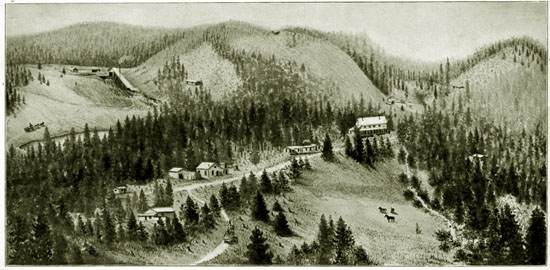
Promotional Drawing,
Gold Hill, Wyoming, 1900.
Gold Hill was the site of a short-
lived gold rush in 1890-91. The gold caused all kinds of excitement in Carbon, the closest point on the railroad. In order to gain from the expected business,
investors in Carbon constucted a stage road the thirty miles to Gold Hill. The stage fare was
$5.00 one way. A stamping mill was installed. The Union Pacific made Carbon a regular stop for the expected hordes
of gold miners. One Carbon, Wyoming, correspondent for the Union Pacific Employees Magazine waxed enthusiastically:
Carbon People have thought about putting up a back stop to catch the gold nuggets as they came from our sister city."
1891, p. 157.
The gold rush, however, ended as fast as it started. At the end of 1891, Professor A.A. Johnson in the first
Annual Report of the Wyoming Agricultural College (The University of Wyoming) & Experimental Station wrote:
THE GOLD HILL MINING DISTRICT. The Gold Hill camp was opened in 1890. The veins on the surface were large, strong and very rich,
but unfortunately at a depth of 100 feet the ore was not worth milling.
A stamp mill was erected and about $3,000 in gold was extracted.
No one has seen fit to prospect at greater depths. If the camp ever amounts to
anything other ledges different from the present ones must be found or the present
ones followed to a greater depth to ascertain their value.
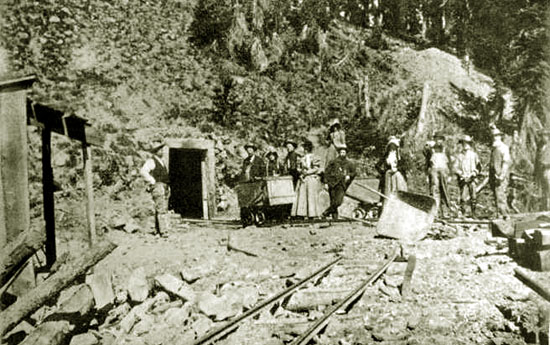
Van Horn Party at Entrance to
the Acme Gold & Mining Co. Mine, Gold Hill, Wyoming, August 29, 1900. In photo (not in order) are
Mr and Mrs. Van Horn, Mr. and Mrs. F. G. Thompson and daughter Evelyn W. Thompson,
Mr. and Mrs. George M. Colby, E. B. Rhoads, Daniel A. Davis, and Caleb W. Marsh.
A 1902 Prospectus for Col. Van Horn's operation exaggerated the gold mine. An accompanying caption for the
above photo claimed that the mine yielded "$43,000 to the ton in gold." That value would be consisten with the approximate 2,100 ounces of gold per ton
referred to by W. Dan Hausel in "Guide to Prospecting and Rock Hunting in Wyoming." Laramie, 2004. However, that
value would not have been typical of the mine. Hausel noted in his "Significant Gold Deposis", Geological Consulting, LLC, Gilvert,
AZ, "the veins are narrow (.5--2 ft.wide) and spotty." In his 1989, "The geology of Wyoming's precious metal lode and placer deposits,"
Hausel noted that specimens were "rare."
Van Horn constructed
a shaft house for a claimed Acme Mine No. 2. and a $2,500 to construct a wagon road from Laramie to
Gold Hill. The mine did not, however, reopen. In 1903, the Company reported in the U. S. Geological Survey, Mineral Resources of
the United States, that it was still engaged
in "developmental" work and expected to open in 1904. Apparently, however, mining on a serious basis did not commence. Western Investors Review, July, 1907 reported that
mining work was going to commence the following Spring.
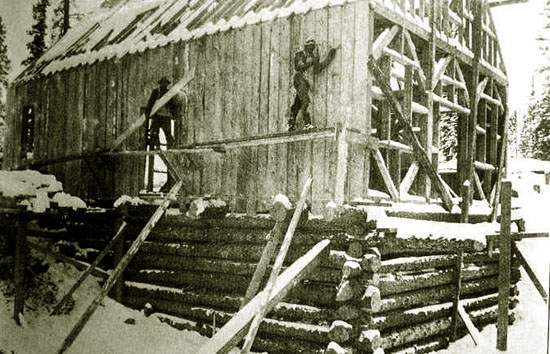
Entrance to
the Shaft House, Acme Mine No. 2 under construction, Gold Hill, Wyoming, 1901.
In 1908, Mining Science reported that the company was hoping for an "early resumption" of
activity at the mine. The magazine noted, however, "The property is equipped with considerable machinery
but has not been systematically worked for several years. The following year, the
1909 Mining Register reported:
Acme Gold & Mining Co.
Wyoming
Office: 7 Congress St., Boston, Mass. Letter returned unclaimed from former mine office,
Laramie, Albany Co., Wyo. L. W. Thompson, president; Fred A. Miller,
vice-president; Arthur S. Howe, secretary and treasurer. Capitalization $400,000,
shares $4 par. Is controlled, through stock ownership, by Acme Consolidated
Gold & Copper Mining Co. Lands, 20 claims, 12 patented, area reported by company
as 5Í4 acres, also a 60-acre mill site. Property, known as the Gold Hill group, has
2,454' of workings. Improvements include necessary mine buildings, sawmill and stamp-mill.
Presumably idle.
7 Congress Street, Boston, was the address of Van Horn's office in Boston.
Next Page: Isaac Van Horn continued, The Laramie, Hahn's Peak and Pacific Railroad.
|